

Preserving Options for the Recovery of Wild Populations






Preserving Options for the Recovery of Wild Populations



An IUCN Partnership Network for Sustainable Captive Management of Freshwater Turtles and Tortoises

The future for Pan’s box turtle (Cuora pani) got a little brighter when two TSA partner institutions, Zoo Atlanta and Riverbanks Zoo, successfully hatched this poorly known Chinese endemic in 2004. Shown here is the Riverbanks Zoo specimen at nearly one year of age.
The mission of TSA is to develop and maintain an inclusive, broad-based global network of collections of living tortoises and freshwater turtles with the primary goal of maintaining chelonian species over the long term to provide maximum future options for the recovery of wild populations.

TURTLE SURVIVAL ALLIANCE BOARD
Dear TSA Supporter:
Rick Hudson
Co-Chair Executive Committee
TSA US Co-Chair
Dwight Lawson
Co-Chair Executive Committee
TSA US Co-Chair
Chris Banks Executive Committee
TSA Australia
Kevin Buley
Executive Committee
TSA Europe Vice-Chair
Hans Dieter Philippen
Executive Committee
TSA Europe Vice-Chair
Hank Zwartepoorte
Executive Committee
TSA Europe Chair
John Behler
Ex-officio Executive Committee
IUCN TFTSG Co-chair
Anders Rhodin
Ex-officio Executive Committee
IUCN TFTSG Co-chair
U.S. Steering Committee
Kurt Buhlmann
Mike Forstner
Greg George
Lisa Lowell
Lonnie McCaskill
Bill Ninesling
Hugh Quinn
Paul vander Schouw
Darrell Senneke
Brett Stearns
Chris Tabaka
Susan Tiedemann
Bill Zeigler
TMG Facilitator
Welcome to the fifth Turtle Survival Alliance Newsletter. This has been an exciting and productive year and while there is much work to be done, we have many accomplishments to celebrate. We write this amidst the preparation and planning leading up to the third annual TSA conference that will be held in San Diego in July. Program Chair Chuck Schaffer and others have assembled a dynamic panel of speakers, and this promises to be a great meeting. The TSA conference continues to grow and is becoming an important gathering of turtle biologists, enthusiasts and conservationists, and we anticipate that the meeting will expand in scope in the coming years.
The most exciting development of 2005 has been the $100,000 grant to the TSA from the Batchelor Foundation. These funds will support much needed range-country turtle conservation programs (see article). We are particularly grateful to Bill Zeigler for cultivating the relationship with the Batchelor Foundation, one we hope to grow over the coming years for the long-term benefit of turtles.
In preparation for administering this grant and to ensure funds are responsibly and effectively directed, we recently visited several turtle facilities in Vietnam, Thailand and Myanmar in conjunction with this year’s TSA sponsored Turtle Husbandry and Veterinary Workshop in Hong Kong. There we reviewed funding priorities, discussed budgets and contract terms and generally familiarized ourselves with the operations. We are happy to report that as our global network expands, the TSA name is becoming more visible, more recognizable and more respected. Increasingly, the TSA is becoming known as a driving force for turtle conservation around the world.
The global situation for turtles remains dire, but it is with extremely guarded optimism that we relate reports that the “complexion” of the turtle markets in China appears to be changing. Observers are noticing a shift towards farm-raised turtles. Still troubling however is the number of forest turtles that continue to be offered in significant numbers in the pet markets. Of particular concern are species such as Geoemyda spengleri, Pyxidea mouhoti and to a lesser extent, Cuora galbinifrons. The turtle crisis in Asia is entering a new phase, where we need to determine what, if anything, is left of priority taxa in the field, and “get a handle” on lower profile species that have not been accorded much attention and could be in danger of falling through the cracks.
As the picture from the field emerges in the coming years, the assurance colonies established in the recent past become ever more important. On another cautiously optimistic note, we can report that significant captive conservation action is underway for a number of the 18 critically endangered Asian turtle species listed in 2000. Internationally networked programs for Batagur baska, Chitra chitra, Mauremys annamensis, Kachuga kachuga, Heosemys depressa and Geochelone platynota are making headway and are positioned to positively impact the survival of those species in the near future. Two species from the 2000 Red List – Heosemys leytensis and Aspideretes nigricans – have been rediscovered in recent years. Rumors of the persistence of Rafetus swinhoei in Vietnam will hopefully be verified soon. Problematic still are the Chinese endemic Cuora, C. galbinifrons, Callagur and the Indonesian endemics, Leucocephalon yuwonoi, Indotestudo forsteni and Chelodina mccordi. For these species, TSA will continue to pursue the development of well-managed captive populations, and leverage the range-country training components of the Batchelor funds to investigate their status and promote their conservation.
While this newsletter reviews the latest achievements and conservation victories, remember the status of many turtle species around the world and at home remains tenuous. Your continued support is critical to the TSA and vital in our combined efforts to assure a future for turtles.
Rick Hudson and Dwight Lawson Co-Chairs, Turtle Survival Alliance

The Turtle Survival Alliance (TSA) recently announced he Turtle Survival Alliance (TSA) announced a significant grant - $100,000 - from The Batchelor a grant - $100,000 - from The Batchelor Foundation. This grant represents the largest single Foundation. This grant represents the donation that the TSA has received in its four-and-a-half year history and will allow the organization to vastly expand the scope of its work, particularly in Southeast Asia. These funds are specifically earmarked for range country turtle conservation initiatives and will focus on capacity building. This generous gift will allow TSA to boost their support to some existing programs in India, Malaysia, Myanmar and Vietnam, while providing new funding to programs in Thailand, Indonesia and southern Mexico. This grant will also fund student participation in the heralded Asian Scholarship Program, bringing aspiring turtle biologists to the U.S. for a summer of training on a wide range of turtle conservation techniques.
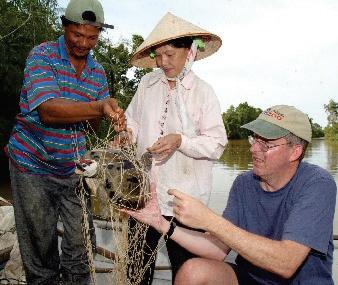
Male painted terrapin is caught as part of the sampling program of the KUSTEM River Terrapin Research and Conservation Project at the Setiu River, Terengganu, Malaysia. Shown here are Mat, a local fisherman employed by the project, Dr. Chan Eng Heng, the project leader and Doug Hendrie, Asian turtle coordinator. (Photo by Victor K.K. Ng)
To help generate interest and expertise in turtle conservation in the region, funds for an Asian Turtle Action Grant program will match $10,000 from the Wildlife Conservation Society. These seed grants will help fund small local projects that are carried out by range state nationals. To build capacity and sustainability into range state management of assurance populations, $10,000 is earmarked to address the critical need for training. An evaluation of existing turtle fa-
cilities in the region has clearly identified a need for technical support designed to improve the quality of captive husbandry and veterinary care of the turtles in those facilities. Experienced veterinarians and experts from TSA will work with local counterparts to improve health care protocols, hatching success, husbandry methods, and management of captive populations at some of these key facilities, furthering the aims of TSA in assisting range state partners in efforts to establish strong and well-run assurance populations of the most critically endangered turtle species within the region.
A ranking of the five most important Asian countries for turtle conservation listed, in descending order: China, Myanmar, Vietnam, Indonesia and India. The newly awarded TSA grant will engage us in four of these countries and provide direct conservation action to
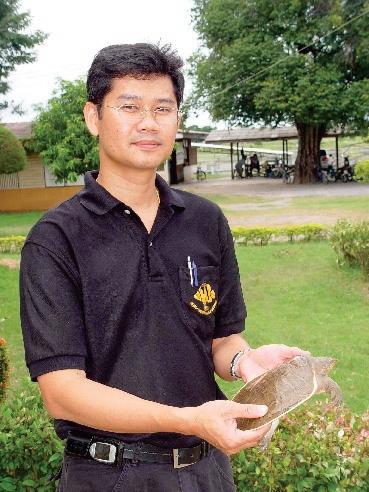
Dr. Wachira Kitimasak holds a captive hatched Siamese narrow-headed softshell turtle at the Kanchaniburi Inland Fisheries Center in Thailand. More than 500 of this IUCN critically endangered species have been hatched here though mortality has been high. TSA funds will work to alleviate this problem.
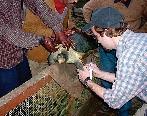
Dr. Shannon Ferrell (Fort Worth Zoo) treats a female red-crowned roofed turtle at the Kukrail Gharial Center in Lucknow, India. Expanding the level of turtle veterinary and husbandry expertise at targeted facilities in Asia is an important goal for the TSA.


Better days are in store for the only captive group of the rare Burmese roofed turtle at the Yadanabon Zoo in Mandalay. The Batchelor foundation grant will fund an expanded new breeding and management facility for this critically endangered turtle.
over half (10 of 18) of the Asian turtle species currently ranked Critically Endangered (CR). In Myanmar, we will support construction of new facilities for the endemic Burmese roofed turtle (Kachuga trivittata), recently rediscovered and now the subject of intensive captive breeding efforts at the zoo in Mandalay. Captive breeding programs for Burmese star tortoises (Geochelone platynota) will also benefit. In Vietnam, support for the renown Turtle Conservation Center (TCC) located at Cuc Phuong National Park will allow that program to expand on a number of fronts. Recognized as a model for range country turtle facilities, the TCC employs a wide range of conservation initiatives including captive breeding (including two CR ranked taxa - Cuora galbinifrons and Mauremys annamensis), education, field research and training of wildlife enforcement officers. In Thailand, funds are earmarked for the softshell turtle breeding program at Kanchanaburi where juvenile rearing facilities will be improved for the striped narrow-headed soft shell turtle (Chitra chitra), ranked CR. In Malaysia, support for an emerging program with KUSTEM (University College of Science and Technology) will bring some much-needed science to ongoing hatching and head starting programs for both mangrove (Batagur) and painted (Callagur) terrapins, both ranked CR. In India, the TSA has launched a partnership with the Madras Crocodile Bank Trust designed to develop and implement conservation action plans for
some of that country’s most endangered turtles, including the redcrowned roofed turtle (Kachuga kachuga ). Finally, breaking out of the Asian realm, TSA will begin working with two existing turtles farms in southern Mexico that are managing large numbers of Central American river turtles ( Dermatemys ) with the aim of developing a large scale reintroduction program.
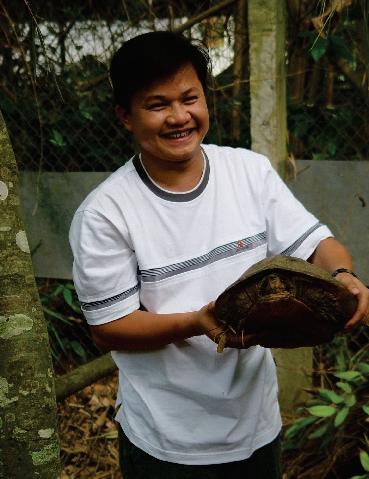
The Cuc Phuong Turtle Conservation Center (TCC) in Vietnam will get a new visitor interpretive center with the Batchelor Foundation funds. Increasing local awareness for the plight of native turtles is an important mission of the TCC. Shown here is Director Bui Dang Phong.
Fast becoming recognized as a global force for turtle conservation, the TSA’s strategy is to identify existing facilities and programs that already have some infrastructure for turtle conservation and work to strengthen them through capacity building. Supporting range country programs that have a captive component capitalizes on the strength of the TSA’s primary expertise. Through husbandry and veterinary training workshops, facility improvements and providing technical, financial and logistical support, the TSA is now well-positioned to exert a serious impact on turtle conservation in some of the global hotspots where they occur.
(Rick Hudson, Fort Worth Zoo)
Captive management programs for both mangrove (Batagur) and painted (Callagur) terrapins at the Satun Inland Fisheries Station in Thailand are expected to benefit from the Batchelor Foundation funds

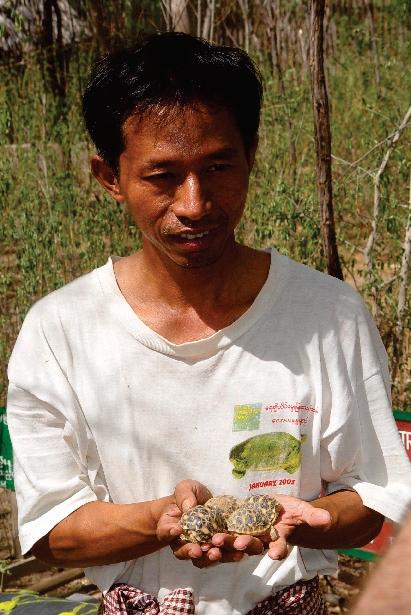
Myint Shwe, warden at the Minsontaung Wildlife Sanctuary, displays some of the 91 Burmese star tortoises hatched there since 2003. Improving security and juvenile rearing enclosures are two objectives of the Batchelor Foundation funds.

Forty-five delegates from nine countries came to attend a four-day workshop on turtle husbandry and veterinary care 30 May through 2 June 2005. Nations represented were China, Vietnam, Myanmar (Burma), Malaysia, Indonesia, Cambodia, Singapore and the U.S. While those present were from diverse backgrounds and nationalities, they were gathered for a single purpose, to learn more about conserving turtles. Represented were professors, CITES management authority staff, forest protection department personnel, veterinarians, non-government organization staff, zoo personnel, turtle rescue center representatives, museum staff, and aquarium personnel. The workshop was designed to help fulfill the goals of the Turtle Survival Alliance (TSA), which is working to expand their global network and build capacity for turtle conservation throughout the region. Kadoorie Farm and Botanic Garden (Hong Kong) graciously hosted the event.
All five instructors had previous capacity-building experience regarding turtle conservation in Asia. Instructors were Dwight Lawson, General Curator of Zoo Atlanta, Rick Hudson, Conservation Biologist at the Fort Worth Zoo, Chris Tabaka, Veterinarian at the Detroit Zoo, Doug Hendrie, Asian Turtle Coordinator for Cleveland Metroparks Zoo and WCS, and Hugh Quinn, General Curator at Cleveland Metroparks Zoo. A variety of methods were utilized in teaching the workshop, including formal classroom instruction, handson experiences in the field and lab and informal discussions about turtle conservation. Kadoorie Farm and Botanic Garden’s living and deceased collection of turtles were also used in the instruction. PowerPoint presentations were available in both English and Chinese, and a translator was provided to interpret all lectures. Two local trips to examine turtle holding facilities were conducted and a field experience to track Chinese big-headed turtles was also provided. During the workshop several topics were discussed, including the TSA, the Asian turtle crisis, species identification, individual turtle identification techniques, record keeping, turtle enclosures and environmental quality, breeding, egg incubation, veterinary care and nutrition, triage, shipping, temporary holding, disposition of confiscated turtles and small population management.
Participants evaluated the course through completion of a questionnaire that asked what topics should be kept, dropped, enhanced and added. A similar workshop was conducted in Singapore in 2004, attracting about 45 people from eleven countries. An evaluation of that course was conducted in the same manner. In both cases, it was revealed that participants found great value in the workshops, and that they felt hands-on activities were extremely beneficial
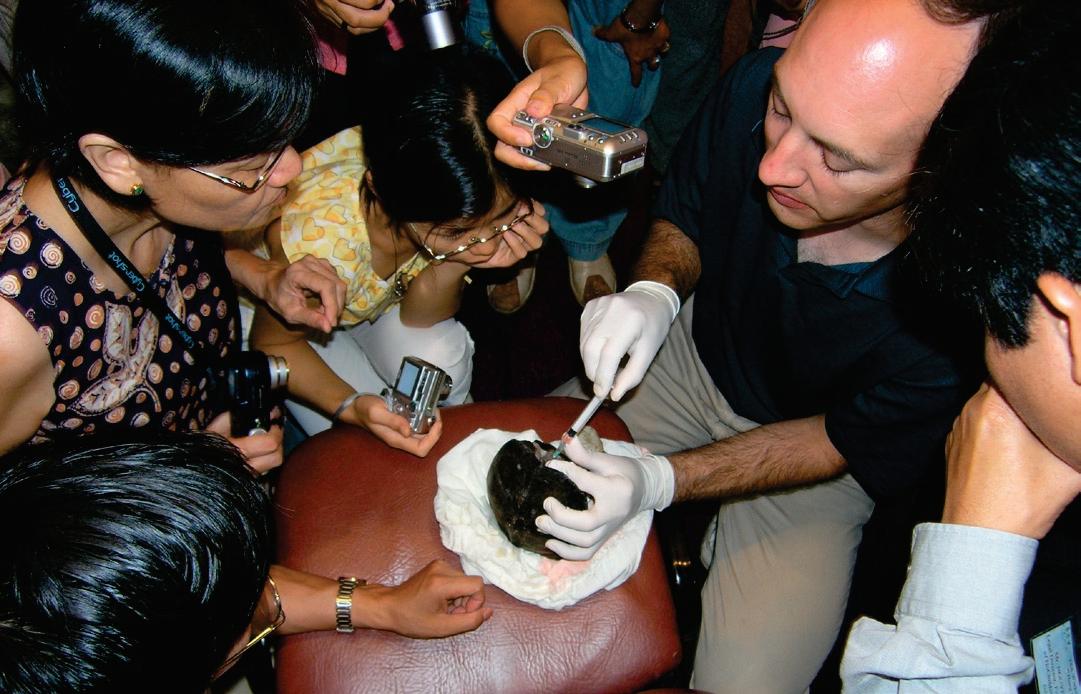
in the learning process. Such input will help improve any future courses offered.
Support to conduct the Hong Kong workshop was provided by Kadoorie Farm and Botanic Garden (KFBG), Cleveland Zoological Society, American Zoo and Aquarium Association’s Conservation Endowment Fund, Institute of Museum and Library Services, and Hong Kong University. A special thanks is extended to KFBG’s Gary Ades, Tan Kit Sun, Paul Crow and Mary Leung.

Meaningful conservation programs are built on the personal bonds that develop among colleagues. Through such relationships, trust and respect open lines of communication that help unify and strengthen the work that needs to

be done. Forming these partnerships is essential in turtle be done. these is essential in turtle conservation efforts. The key outcome of the workshops described above is for all to communicate openly and collaborate fully. The success of turtle conservation efforts depends on this.
(Hugh R. Quinn, Ph.D., Cleveland Metroparks Zoo)

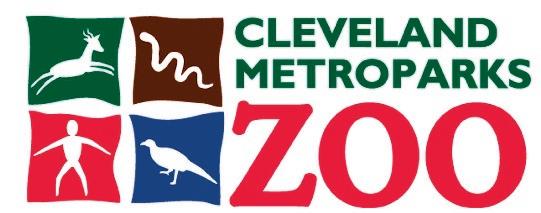
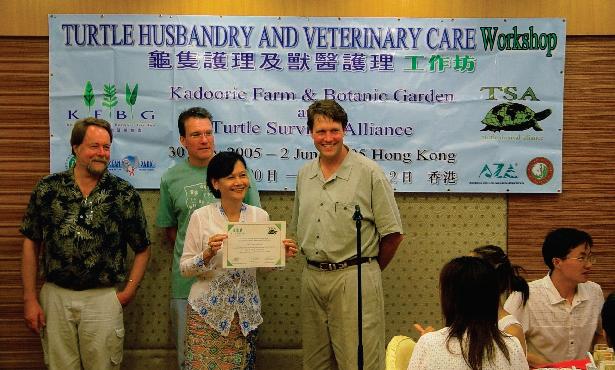
The North Carolina State University College of Veterinary Medicine (NCSU-CVM) Turtle Rescue Team (TRT) is a veterinary student-run organization that treats native sick and injured wild Chelonians. Approximately 40 underclassmen plus about 10 staff and visiting volunteers participate in this clinical program. Currently in its ninth full year, the TRT students have treated over more than 1,250 native turtles belonging to nine different species. Most cases present as vehicular trauma. Dogs, lawnmowers, fishing gear and even horses have also caused injury requiring medical treatment. First, second and third year students are responsible for case management, coordinating consultations, diagnostic testing within the hospital and placing recuperating animals with local wildlife rehabilitators. Several clinical research publications have resulted from the opportunity to work with these wild reptiles. The NCSU-CVM TRT is a volunteer organization that relies primarily on donations for financial support.
The three major goals of the TRT are to: 1) provide underclass veterinary students an opportunity to work with and manage clinical wild turtle cases, 2) provide competent and state-of-the-art veterinary care to sick and injured wild turtles and 3) provide clinical case material for the generation of new knowledge in the form of peer-reviewed publications.
In early 2002 the TRT became a partner and TSA member following the 2001 Hong Kong Asian turtle rescue effort and began the first of several efforts on behalf of threatened Asian turtles. To date, the TRT worked has worked with the
following Asian species: Carettochelys insculpta, Cuora amboinensis, Heosemys spinosa, Notochelys platynota and Orlitia borneensis. These turtles have provided a valuable and unique educational experience for our veterinary students and TRT volunteers. The NCSU TRT is honored to be a TSA partner and looks forward to continued collaborations in the years to come.


The last two years have seen a renewed interest and new hope for captive management of the historically problematic impressed tortoise, Manouria impressa. In early 2005, there were nearly 50 partners expressing interest in the M. impressa TMG, and recent importations had bolstered the population held by TSA partners to approximately 50 animals.
Although medical complications continue to plague imports – and even established animals can experience rapid, dramatic declines in health – several TSA veterinarians are focusing on this taxon and progress in their medical care and husbandry is being made. The species seems unusually prone to stress and aggressive treatment and rehabilitation is almost always necessary. Wild-caught animals are notoriously finicky, often responding only to a diet heavy in expensive oyster mushrooms. Complicating this, imports are often nutritionally debilitated and require lengthy rehabilitation. Amoebic infections are pervasive and require aggressive medical intervention. Some infections appear to be chronic and require prolonged, routine prophylactic treatment.
An importation of 14 Manouria impressa by Zoo Atlanta in 2004 illustrates the problems and possibilities this species entails. These animals were brought to the U.S. as part of a capacity building and animal exchange project between Zoo Atlanta and the Chengdu Zoo, China. Upon arrival, several of the tortoises exhibited classic problems associated with recent imports. They were emaciated (impressed tortoises are finicky eaters and take time to acclimate and require a peculiar diet heavy on mushrooms) and suffered from amoebic infections. X-rays revealed that two animals had severe intestinal impactions of rocks and gravel. After non-invasive methods failed to move the impactions, surgical intervention was necessary to remove the rocks. Attesting to the durability of even this notoriously delicate species, both animals recovered and are now doing well. With intensive medical

intervention and constant monitoring, 11 of the 14 animals have survived through the first year. This spring, the 2.4 that remained at Atlanta began exhibiting courtship and breeding behavior, and the herpetology staff are cautiously hopeful for reproduction.


A male in an outdoor enclosure at Zoo Atlanta. Following marks the initial stage of courtship in .




Recent reproduction of Recent of in the U.S. involving a long-term captive animal owned by one TSA partner adds to animal owned one TSA partner adds to the air of optimism for successfully establishing an the air of for an ex situ population. These offspring add to the 3.3.3 captive born These add to the 3.3.3 born animals obtained from wild-caught imports in the 1990s animals obtained from in the 1990s that should be nearing reproductive maturity. Provided that that should be nearing maturity. Provided that TSA veterinarians and interested partners can continue to TSA veterinarians and interested partners can continue to make progress on husbandry and medical issues to establish make progress on and medical issues to establish additional potential founders, the prospects are good for the additional the prospects are for the development of a small, but enthusiastically managed popu- of a but population in the next five years. lation in the next years.








Two surgeries to remove gravel impactions in this delicate species were remarkably successful and both tortoises survived.
The status of Manouria impressa Manouria in the wild remains unclear. On a positive note, the species is distributed over a clear. On a note, the is distributed over a fairly wide, often remote and mountainous area of Southeast often remote and mountainous area of Southeast Asia with several populations occurring in protected areas. Asia with several in areas. However, even in pristine areas, impressed tortoises are not However, even in areas, tortoises are not common, and relatively little fieldwork has been done. Basic natural history studies would be invaluable in promoting in situ conservation and improving captive husbandry. Additional facilities and dedicated partners are still needed to hold specimens and help perfect husbandry techniques.
If you are interested in participating in this developing TMG, please contact Dwight Lawson at dlawson@zooatlanta.org.
(Dwight Lawson, Zoo Atlanta)


These new breeding ponds have recently been constructed at MCBT and will greatly expand their capacity for managing targeted endangered freshwater turtles in captivity.

Apartnership launched in 2003 between the TSA launched in 2003 between the TSA and the Madras Crocodile Bank Trust (MCBT) to and the Madras Crocodile Bank Trust to conserve India’s freshwater turtles and tortoises is conserve gaining momentum. With an infusion of financial support - $30,000 in 2004 and 2005 - new construction and facility renovations are now underway at both the MCBT in Chennai and the Kukrail Gharial Center in Lucknow. Staff dedicated to turtle conservation work have been hired by MCBT, and plans for the workshop are in full swing again. Originally scheduled for January 2005, the Conservation and Action Plan for Freshwater Turtles and Tortoises of India workshop was postponed due to the devastating effects of the December 2004 tsunami. This important workshop has now been rescheduled for 17 - 20 October 2005, at the Kukrail Breeding Centre in Lucknow, Uttar Pradesh (UP) province. Organized by the MCBT/Centre for Herpetology and the UP Forest Department, with financial support from the TSA, this workshop is expected to produce a blueprint for turtle
conservation in India. By systematically identifying the most threatened chelonians on the Indian subcontinent and writing action plans for their recovery, this workshop will provide a solid foundation for matching donors with projects in need of funding. In essence, a “who will do what, when and how” document will be produced for each species in need of urgent research or conservation action.
Major supporters for this initiative include the British Chelonia Group (~$8,000), Turtle Conservation Fund ($7,500) and the Turtle Survival Alliance ($14,500). Those contributing to the India project on behalf of TSA are Jim & Kirsten Kranz ($3,000), Detroit Zoo ($5,000) and Zoological Society of San Diego ($5,000). An additional $15,000 is earmarked for India under the new Batchelor Foundation grant.
(Rick Hudson, Fort Worth Zoo)
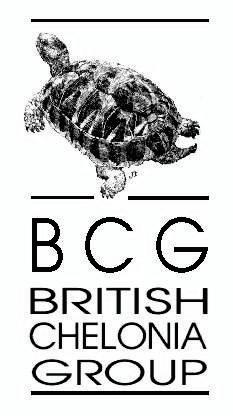
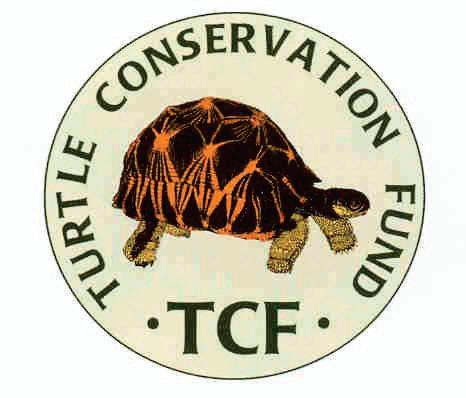

For the second consecutive year, MCBT has successfully hatched red crowned roofed turtles, Kachuga kachuga, an IUCN Red List critically endangered species targeted for intensive conservation action.


The TSA announced it has awarded their second Partner Grant to the Knoxville Zoo to conduct temperature dependent sex determination (TSD) studies on four species of tortoises. The proposal was submitted by Michael Ogle (Department of Herpetology) who will focus on four species: Indian star tortoise (Geochelone elegans), Burmese star tortoise (Geochelone platynota), Madagascar spider tortoise (Pyxis arachnoides) and Madagascar flat-tail tortoise (Pyxis planicauda). Of the 46 species of tortoises, TSD studies have been conducted on only five, and all species researched so far have exhibited a TSD pattern. The grant is for $1,497 and will allow the Zoo to purchase three Lyon incubators for these studies. This flattailed tortoise is one of the species expected to benefit from TSD research.
In September 2004, the Knoxville Zoological Gardens (KZG) was pleased to announce the hatching of our first Heosemys spinosa, only to be followed by its clutch mate five days later. A few months later, in December, a third neonate hatched. All three hatchlings were from the same female, one of a group of 1.3 received here on 20 August 2002 from TSA. The eggs were incubated following a protocol successfully utilized by Dennis Herman, when Zoo Atlanta hatched its first spinosa over 10 years ago. The eggs are initially incubated at 82oF (27.7oC) for 35 days, and then brought into a cooler area where they complete incubation at 78oF (25.5 oC). The total incubation time has ranged from 113-118 days. The neonates have grown very well on a diet of chopped greens, vegetables, and fruits (especially mangoes) fortified with crushed Turtle Brittle, and from time to time they will also consume earthworms and pinkies.
During the first half of 2005, KZG has produced its fourth Pyxis planicauda in three breeding seasons, adding our third bloodline to the captive-bred population. As we found out in May 2002, the key to successful incubation with this species is a sufficient cooling period prior to actually placing the eggs in the incubator. For three to four months the eggs are placed in a cool section of the building where the day time highs are in the mid-70soF with a nighttime drop into the 60soF. Only after that time period are the eggs placed into the incubator. We also start spraying the eggs once per week to increase the humidity. From our successful hatchings, blood vessels become evident in the egg anywhere from two through eight weeks post-cooling. Hatching has ranged from 98-117 days post-cooling. There is still much to learn about captive reproduction in P. planicauda and hopefully as TSA Partners work together we can do just that.
In comparison to the low fertility rate we have seen in P. planicauda eggs, P. a. arachnoides fertility has been very high. Of the 20 eggs produced in this breeding season, 17 have been fertile and 15 have hatched to date. The spider tortoise eggs are incubated for the first four-six weeks at 87oF (30.5oC), when they are then candled to check for development. If no development has occurred, the eggs are placed in cool area (65-75oF or 18-24oC) for four weeks. Eggs are then placed back into the incubator at which point it appears that development begins. On several occasions eggs had to be placed back into the cool area a second or even third time. There has been a wide range of incubation time during the post-cooling period in P. a. arachnoides. A few hatchlings emerged in as little as 101 days, but this incubation period in most of the eggs was much longer, ranging up to 257 days.
(Michael Ogle, Knoxville Zoological Gardens)



The natural history of many Asian turtle species is poorly understood. To the extent possible under captive conditions, Savannah River Ecology Laboratory (SREL) is collecting data to determine diet preferences, document behavior and social interactions, assess microhabitat selection and temperature tolerances, observe mating and reproductive cycles, measure growth and assess health parameters of select Asian turtle species.
Status and Goals of the Asian Turtle Project at SREL:
1. SREL is currently providing care and maintenance of 320 individual turtles, representing 30 species. These turtles were made available through government confiscations of illegally traded animals or have been contributed by TSA partners. The turtles incorporated into this project to date have been acquired through the efforts of the Turtle Survival Alliance to obtain confiscated turtles for conservation and research.
2. Existing holding facilities have been modified, as needed, to accommodate the varying needs of different turtle species. The information collected and lessons learned are assisting in the development and implementation of non-native turtle research and husbandry protocols. SREL, in collaboration with the University of Georgia Vet School, is providing veterinary treatment and conducting necropsies, as needed.
3. The overall goal of the project at SREL is to conduct specific studies with these turtles that will produce publishable results and assist in the development of assurance colonies and field conservation management plans for these endangered species. These studies represent priority needs of both the Turtle Survival Alliance and the Savannah River Ecology Laboratory.
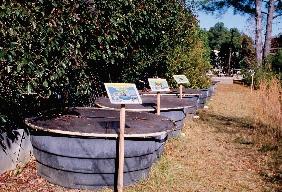

The Cuora amboinensis in the SREL collection were obtained through the January 2001 confiscation. Many of the females were gravid at that time; however, none of the turtles produced eggs during 2002 or 2003. One female produced two eggs in 2004 (which resulted in one hatchling) and all seven females have shelled eggs in 2005. Two noteworthy observations: 1) recovery of these badly damaged animals probably resulted in a delay in reproduction for several years; and 2) egg-laying period shifted from January (in 2001) to June (in 2005).
Mating Observations: Two mature animals from the Hong Kong confiscation had been kept separate by a plexi-glass divider but in the same tank and water (thus aware of each other’s presence) all winter (2004-05). The divider was pulled, allowing the female and male to interact. On 15 April 2005, the female was observed violently head bobbing at the male (seemingly telling him to leave her alone) as he kept swimming up to her face. He made one attempt to mount her from behind, upon which she rushed away from him and buried in the sand. On April 21, 2005, the turtles were observed mating. They were locked together with the posterior portions of the shells in contact, and their heads at 180 degrees away from each other. Both took turns dragging the other for short distances. They separated after about three minutes. It is unknown how long they were joined before being observed.
The female has a midline carapace length of 212 mm, and this is the first time she has produced eggs.
On 12 June 2005, radiographs documented five faintly calcified eggs. A second radiograph, taken on 28 June 2005, shows seven small, calcified eggs.

Terrestrial Aestivation: During summer 2004, both sexes were observed to engage in periods of terrestrial dormancy. These turtles left the aquatic habitats and buried themselves in loose sandy soil under humus and leaf debris for periods of up to two weeks.

Courtship Observations: In early June 2005, courtship behavior was observed underwater in a pool in an outdoor aviary habitat. The males have been observed to display to the females by facing them with their heads fully extended while swimming forward and backward. A pool and stream habitat were built in a converted aviary at SREL. It has been noted that some males will leave the aquatic pool and seek refuge in terrestrial habitat.

This aviary has a 4’ deep pond flowing into a 30’ stream and marsh. It supports groups of Sacalia quadriocellata (12.10), Cuora trifasciata (3.5), six subadult Platysternon megacephalum and Mauremys annamensis (2.2)
Territoriality: A flowing stream system has been set up in a greenhouse and staff are varying the number of cover objects (concrete blocks) to determine the density of males that can be kept together. The individual males are showing fidelity to certain cover objects. Preliminary corroborative observations from the radio-telemetry study at Kadoorie Farm and Botanic Garden in Hong Kong indicates that only one male is usually found in each stream pool.
A large sample size of deceased turtles from the TSA Hong Kong confiscation and the Tewksbury Institute of Herpetology will be used to determine if particular hazards to human health may exist from consuming turtles as
food. Specifically, tissues will be analyzed (liver, kidney, food. tissues will be (liver, leg muscle) for elevated mercury concentrations. To date, adequate sample sizes for up to 13 species of Asian freshwater turtles are available. Large sample sizes of Siebenrockiella crassicollis and Cuora amboinensis exist. A few of the other species include Pelochelys cantorii, Chelodina parkeri, Leucocephalon yuwonoi, Pxyidea mouhouti and Cuora galbinifrons.

(Kurt A. Buhlmann, Cris Hagen, Tracey D. Tuberville and J. Whitfield Gibbons, University of Georgia)

The Riverbanks Zoo and Garden in Columbia, South Carolina, has maintained 2.2 Cuora pani for several years. The turtles are housed outdoors in metal stock tanks year round. In April of 2004, the two female C. pani were separated were from the two males and housed in a separate stock tank. In May, a single male and a single female were placed together in a tub containing 120 mm of water and 25% dry land area. The turtles were left together for several hours and then separated. Each male was introduced to each female several times: however, no breeding activity was ever observed. On June 5, the two female turtles were radiographed revealing five eggs in one female and none in the second. These eggs were deposited in a nest on July 3. The eggs were incubated in a closed plastic container on 2:1 vermiculite /water at 31° C. On August 29, one of the eggs hatched, producing a healthy hatchling turtle. On September 2, a second egg hatched: however, the hatchling died a short time later. Of the three remaining eggs, two that were cracked during nesting were opened and contained a partially developed dead embryos and the third was infertile.
The surviving hatchling weighed 5.0 g and measured 26 x 21 mm. It was fed daily, alternating between Nasco Turtle Brittle and live food. Live food consists mainly of black worms, but earthworms and “white” mealworms are occasionally offered. Growth has been rapid, and 86 days after hatching, the neonate had tripled its weight to 16 g and length/width to 46 x 40mm. After 174 days, weight had increased to 30 grams. (Scott Pfaff, Riverbanks



TSA Co-Chair Dwight Lawson’s success with Heosemys depressa continued this year with six hatchlings. Two females from the group of 2.3 animals laid four eggs each in early–mid January. Two eggs were cracked during deposition, but the remaining six hatched after 144–180+ days in moist vermiculite. With the single hatchling produced from a clutch of four eggs at Zoo Atlanta this year, there are now nine known captive bred offspring from three founder females. At least two other individuals or institutions got eggs this year, but none appear to have been fertile.




Last year’s two offspring are doing well and are now approximately 110 mm SLC. Dwight is currently writing up a more detailed description of captive reproduction in this species.
Three new founder bloodlines were added to the Mauremys annamensis TMP in 2004. Thirteen offspring from two founder pairs were hatched by Rick Hudson and five from another founder pair were produced at the Fort Worth Zoo. From these groups of progeny, a new F1 colony has been established at St. Joseph University in Philadelphia under the direction of Dr. Scott McRobert.



Several TSA partners had breeding success with past year. Melody Hartley hatched one on 17 September 2004, from one of two eggs laid on 30 June 2004. The egg was incubated in moist coco-peat at 8082o o C) for 75 days. Julie Tougas hatched two C. (photo at right) on 13-14 August from eggs laid 26 May 2004. A sporadic breeder ex situ, is reproducing well at the Cuc Phuong Turtle Conservation Center in Vietnam.



Chris Tabaka and Sharon Chancellor combined efforts to hatch these two in September 2004, and Chris reports success again in July 2005. This form has an extremely restricted range in southern Vietnam, and their future survival in the wild is highly at risk. To the best of our knowledge, these represent the only (g.) hatchlings in the US, and bourreti has still not reproduced successfully.
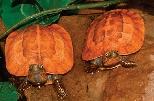



The Zoological Society of San Diego recently celebrated the successful reproduction of the critically endangered Rote Island snakeneck turtles, Chelodina mccordi. A clutch of 15 eggs was discovered buried on a nest beach on 26 February 2005. The clutch was removed for incubation, and after 112 days, they began hatching. Eight hatched and will represent a new bloodline for this species. Additional clutches are incubating.
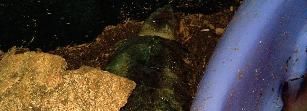
One of TSA’s few Canadian partners, Julie Tougas, continued her streak of significant captive breedings when she announced the hatching of a big-headed turtle, Platysternon megacephalum. Of five eggs laid on 29 July, three banded but only one hatched. Both parents are long-term captives and have been with Julie for four years.


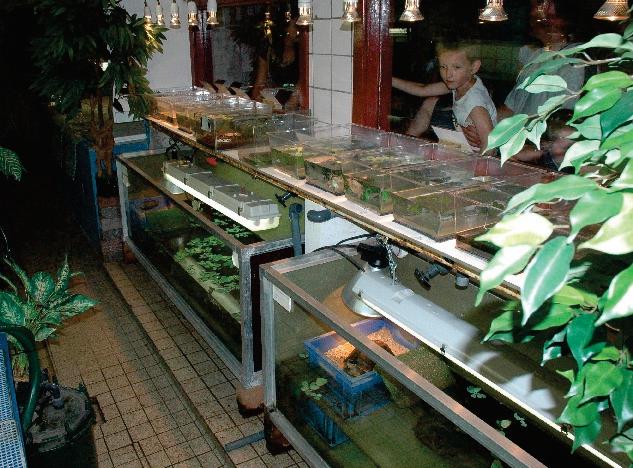
This behind-the-scenes turtle rearing area at Rotterdam Zoo can now be viewed by the public.
The number of turtle species at the Rotterdam Zoo increased to 28 over the last few years, at least 16 of which are under some degree of threat as defined by the IUCN Red List. Some remarkable breeding successes have been achieved over the last few years such as Cuora trifasciata, Mauremys annamensis, Chelodina mccordi, Geoclemmys hamiltonii, Geochelone radiata, Pyxis arachnoides, Indotestudo elongata, and very recently in April 2005, 16 Carettochelys insculpta hatched from two females (Visser and Zwartepoorte, 2005, in press). A short video of the underwater hatching is shown on the Rotterdam Zoo website.
The majority of the turtle species can be seen in the public collection of the zoo, but a number of species are also kept in off-exhibit areas, creating better breeding situations. For decades, a few turtle hatchlings could be seen in a small incubation/rearing room where other reptile species hatchlings are exhibited during the first few months of their lives. A large number of turtle hatchlings were however kept behind-the-scenes and in the former fish section quarantine. This last off-exhibit room is now open to the public, and through large glass windows, the breeding results are displayed to the public. In 13 small containers, hatchlings of six endangered species are exhibited and, in five larger tanks, a few older captive-born juveniles can be seen. Information on the endangered status of the species in the wild and on how the breeding results are achieved is provided by large information panels in the public area. This turtle breeding centre was opened on 13 April 2005 together with the launching of the EAZA Shellshock campaign within the Dutch Zoo Federation (NVD) and was witnessed by a large number of press. (Henk Zwartepoorte, Chair, TSA Europe)







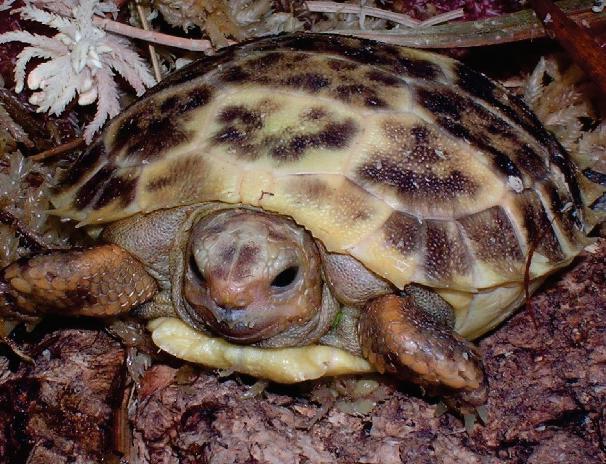
The past six months have been very exciting for the Chelonian program at Zoo Atlanta. Throughout the spring our group of 5.4 Burmese star tortoises, Geochelone platynota, on loan from the private sector, have been breeding on a daily basis. We are watching for eggs of this critically endangered species in the near future. On a similar note, our group of 3.4 impressed tortoises, Manoria impressa, is acclimated and becoming established after a long quarantine. These animals are part of a group of 14 imported in August 2004 in an exchange with the Chengdu Zoo, China. The impressed tortoises have been eating well and gaining weight for 10 months now, and have been exhibiting breeding behavior as the weather has warmed over the last few weeks. It is interesting to note that both male-female and femalefemale aggressive interactions have been observed, but so far no male-male aggression has been seen.
Zoo Atlanta’s Herpetology Department is also happy to report a number of significant hatchings in May and June. After approximately 150 days of incubation, 13 of 14 Mata Mata, Chelys fimbriatus, hatched. The first neonate hatched on its own, but the remaining 12 needed assistance out of the egg. The eggs appeared to be very heavily calcified and future eggs will be incubated in an acidic environment to try and achieve a degradation of the calcium concentration in the shell. Two Forsten’s tortoises, Indotestudo forstenii, hatched in June. Both neonates were very alert and aggressive from the beginning, each puffing up and hissing at their observers while pipping from the egg. These hatchlings are the third and fourth individuals of this species to be hatched at the zoo, and represent one of the few consistent breeding pairs of this species in captivity. Additional hatchings of note include one Arakan forest tortoise, Heosemys depressa – only the second time this species has been reproduced in captivity, and a still fairly rare hatching of a spiny turtle, Heosemys spinosa.
We have a number of eggs of various species in the incubator. These include radiated tortoise, Astrochelys radiata, flat-tailed tortoise, Pyxis planicauda and eggs from a pair of potential founder Burmese brown tortoise, Manoria emys phayrei. Finally, a number of hatchlings from last year are growing and acclimating too well. Three yearling Pyxis planicauda are fast approaching the 50 gram mark. This weight has been associated with increased mortality in some hatchlings of this species, so we are trying different management and husbandry approaches and will report on the success of each in a later issue. Our three yearling Pan’s box turtles, Cuora pani, are also doing very well. Captive born individuals acclimate well and are actually personable and visible, unlike their adult counterparts. Three Pan’s box turtles hatched at Zoo Atlanta on August 16-17 from eggs found on June 21, 2004.
(Brad Lock, DVM, Zoo Atlanta)
Though considered fairly common and with a widespread distribution, Notochelys is monotypic and therefore remains a species of special concern for the TSA. With a problematic history in captivity, and reproduction nearly non–existent and rarely reported, much remains to be learned about this enigmatic turtle before sustainable captive populations can be established. The number of Notochelys available to the TSA as reported by the TMG coordinator, Susan Tiedemann, is 60 adult specimens. These animals are comprised of two separate geographic groups. One group is believed to be of Malaysian origin and the other is of definite Sumatran origin.
The majority of these 60 animals are being housed and maintained at the Savannah River Ecology Laboratory (SREL) by Cris Hagen. The Sumatran group is comprised of eight males, seven females and six unsexable individuals. The Malaysian group consists of seven males and 14 females. Notochelys are rarely aggressive with one another, which allow staff to maintain two groups of 21 animals each in large aquatic enclosures. Another group of 1.5 TSA Notochelys from a 2004 confiscation are expected to be transferred to SREL sometime during summer 2005.
Once acclimated, housing for Notochelys is fairly simplistic. They are extremely aquatic and thrive at water temperatures between 70 – 80o F. A basking site is provided but is rarely used, and most individuals prefer low light levels. However, some juveniles and young adults have been observed to actually haul completely out of the water to bask and dry off under an artificial light source. At SREL, these turtles are housed in 12’ x 12’ smooth concrete enclosures with a constant open flow of fresh water. They are fed a variety of greens, fruits, vegetables and commercial turtle and trout chows.
These animals are all acclimated, with many of them now four - five year captives. At this point, our primary goal is to promote successful captive reproduction. At SREL, frequent observations include male to male combat, courtship and mating. Breeding behaviors have been regularly induced when flowing, cool (~65o F, 18.5o C) water is introduced to an enclosure.
In summary, we are moving forward with this species. There is still much to learn, but there is a good deal of basic knowledge now in place. As an organization, we will continue to give serious attention to this species, and hopefully ,in the near future, we can start placing F1 hatchlings with TSA partners to be raised for future generations.
(Cris Hagen, SREL)

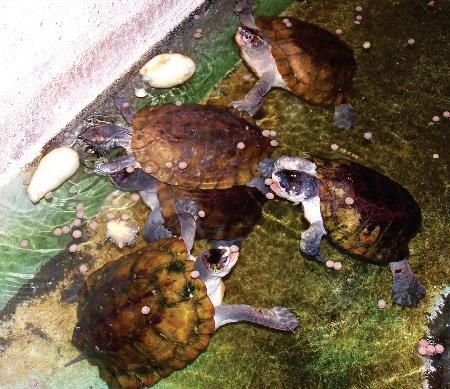




In this article, Gregory George relates his experiences launching an in situ conservation program for Dermatemys.
In 2004, I attended the TSA annual meeting in Or- n 2004, I attended the TSA annual meeting in Orlando, Florida, with a motley group of some of my lando, Florida, with a group of some of my work colleagues and fellow turtle enthusiasts. Filtra- work and fellow turtle enthusiasts. Filtration, plants, artificial rock and aquarium design is the tion, artificial rock and is the group’s forte. Aside from enjoying the lectures, we made a pact between ourselves to identify a species and/or project in which we would be able to participate in. We wanted to fund field research as well as the management of an assurance colony. After meeting Dr. Richard Vogt and attending his presentation on the Central American river turtle, Dermatemys mawii, it was decided that this was the project with greatest potential. We discussed our objectives and opportunities in supporting and improving an existing captive management program for the Central American river turtle in Mexico. This led my wife Lisette and me to attend the Dermatemys mawii forum being held during the VIII forum held the VIII Mexican Society of Herpetology National Meeting in Villahermosa, Tabasco, Mexico, in November. We considered our visit to Tabasco as a preliminary fact finding mission to determine the scope and work necessary to meet our team’s objectives.
During the forum, we were introduced to the principle researchers and the staff of the government turtle farm in Nacajuca, Tabasco. This farm maintains all native turtle species found in Tabasco, more than 800, the largest group of this species in captivity. With the help of Dr. Richard Vogt and Gracia Syed, the Mexican Coordinator of Restoration and Conservation for Dermatemys, meetings were arranged to discuss a potential cooperative project and survey the known captive populations of D. mawii within the state of Tabasco. within state We spent three days working at the farm in Nacajuca with


the technicians as they performed their daily husbandry routines.
Through our interviews and observations with the staff, we formulated strategies to improve water quality within the holding tanks and prioritized potential repairs of cement tanks and waterlines.
The high density of many turtle species throughout the farm was evident due to many tanks being empty and needing repair. We also assisted Gracia in collecting morphometric data and DNA samples on 120 Dermatemys in hopes of identifying origin and locality information from these samples. One day was spent at Yumka Zoological Park speaking to the Director and staff regarding management of their population of 20 Dermatemys housed in a large aviary pool. They allowed us to weigh and measure these individuals as well as collect DNA samples. On a separate occasion, we visited a private, family operated farm in La Encantada. This facility houses and reproduces several native turtle species and is working with the government farm to obtain 100 Dermatemys to be placed in two newly constructed, half acre, in-ground holding ponds.
Our visits to these various facilities resulted in identifying a plan of action to join forces with local researchers and husbandry technicians in initiating a long term project to increase survivorship of Dermatemys at the government farm as well as in the wild. The actions at the farm included constructing a filtration system for the Dermatemys holding ponds, developing a husbandry protocol for all turtle species and a preliminary design for an interpretive center. Another key component identified is to support the field work of Claudia Zenteno, M.S. of the Universidad Juarez Autonoma de Tabasco in the Bioreserve Pantanos de Centla in an effort to develop a reintroduction program with D. mawii. Linking the work of turtle farms and field researchers may prove vital to the survival of Dermatemys in Mexico.
Nacajuca farm technician Narciso collecting Dermatemys eggs recently laid by a female after being moved to a fresh new pond. Narciso is considered the expert egg collector at the farm and is shown here after “noodling” for a nest. The eggs were deposited in a cavity about 12” (30 cm) below the water.
In May 2005, David Manser of Ponds and Plants Nursery and Jay Allen of Aquarium Innovations and I traveled to Nacajuca to install the filtration and participate in a field survey. With the enthusiastic participation from the Nacajuca staff, repairs of cement troughs were made and waterlines were established before the filters were constructed. Then two submersible pumps moving approximately 50 gallons per minute were installed
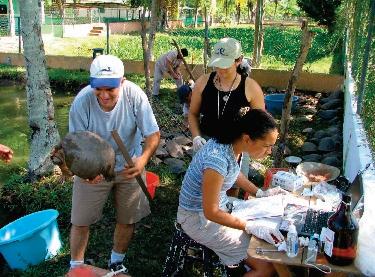
in each of the two, half-acre Dermatemys holding ponds. These pumps create circulation and increase dissolved oxygen within the ponds in an attempt to recreate more of a riverine environment for these turtles which were living in stagnant conditions. Half of the water pushed by the pumps is directed to two neighboring cement troughs where biological filters utilizing water hyacinth and gravel were constructed. Carpentry and plumbing tools as well as a digital scale and calipers were donated to the farms equipment room.
It is our goal to continue support field research and the husbandry work at the government facility in Nacajuca with the hopes of initiating a reintroduction program for captive bred and raised Dermatemys. These efforts will increase international awareness of Dermatemys mawii conservation issues and supply valuable information to the Turtle Survival Alliance as they embark on funding projects for this species in Mexico.


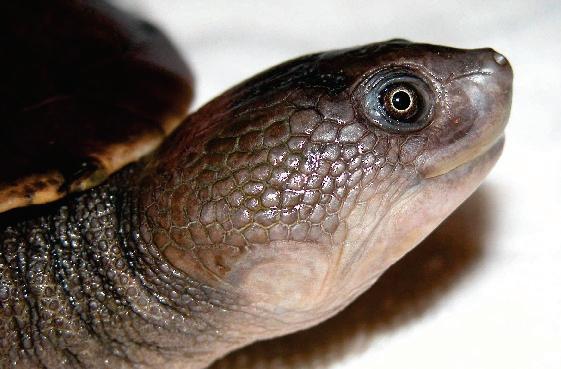
A joint collaboration between the Denver Zoo and the TSA is working to implement a captive management program for the Reimann’s snakeneck turtle (Chelodina reimanni). This obscure turtle was first described by Philippen and Grossmann in 1990 from the Merauke River in Southeastern Irian Jaya. After its description, the species was exported in limited quantities until the year 2000 when they seemed to disappear from the trade. Extensive search efforts were made by local collectors but came up empty handed. Endemic to Indonesia and with a range and status that is poorly known, this snakeneck has emerged as a species of special concern.
In response to these findings it was decided that a Taxon Management Group (TMG) should be formed, with the fear that this species may have been over-collected for the pet trade. This TMG was organized by Gregory Cosentino, a private individual in New York with extensive experience in raising juvenile Chelodina. The goal of this plan is to bring together the holdings of the few institutions and private individuals that maintain this species. With the support and cooperation of Rick Haeffner, a head-start program was set up whereby juveniles would be sent from Denver to New York, to be grown by Greg, after which they would be distributed to various members of the TMG. Historically, babies of this species have not fared well in captivity, and it is believed that of the 250+ hatchlings produced at the Denver Zoo, only a handful survived following distribution. The TMG hopes to reverse this negative trend. Founder representation (the number of wild-caught adults that have reproduced in captivity) is 5.11, located in four TMG participating collections. Recently, there have been a handful of wild caught adults available in the trade. We hope that these animals find their way into the hands of the people dedicated to the goals of the C. reimanni TMG.
(Greg Cosentino and Rick Haeffner)

The TSA gratefully acknowledges the following donors for their generous contributions of $100 or more for turtle conservation.
Batchelor Foundation
Marvin Bennett
Jack Cato
Central Illinois Herp Society
Columbus Zoo
Dallas Zoo
Denver Zoo
Fort Worth Zoo
Kansas City Herp Society
Ed Louis
Mary Rosenfeld
David Shapiro
Gary Wilfong
Special thanks:
2005 TSA Conference Sponsors
Bushmaster Reptiles
California Turtle & Tortoise Club
Chelonian Research Foundation
Chelonian Research Institute
Disney’s Animal Kingdom
Greg and Lisette George
Purina Mills / Mazuri
Reptiles Magazine
Brett and Nancy Stearns
Zoo Med Laboratories, Inc.
Zoological Society of San Diego
Our thanks to the Lowry Park Zoo in Tampa, Florida, for sponsoring and hosting the TSA U.S. steering committee meeting in February 2005. Dustin Smith did an outstanding job of ensuring that our local arrangements were made and that we were well cared for. Good job Dustin!! Thanks also to Zoo Atlanta for sponsoring our travel to Tampa with Delta airline vouchers.
And special thanks to Don Boyer and his group at the San Diego Zoo for their extreme generosity in hosting the TSA’s 2005 annual conference, and Chuck Schaffer for an outstanding job as the 2005 TSA Conference Program chairman. For local support we thank the California Turtle & Tortoise Club for helping bring the TSA conference to the West Coast.
Again, this issue of the TSA Newsletter is dedicated to some of the workhorses of the TSA whose commitment and dedication have contributed so much to the success of this organization: Bill Ninesling (animal management), Annabel Ross (records and permits), Darrell Senneke (web site, communications), Lisa Lowell (membership), Lonnie McCaskill (conference organization, merchandising), Hugh Quinn (training workshops, fundraising), Chris Tabaka, Sam Rivera, Shannon Ferrell, Joe Flanagan and Greg Fleming (veterinary support) and Meg Bommarito (newsletter layout and design). Finally, we owe a great deal of thanks to the Fort Worth Zoo for its strong and steady institutional support for the TSA. The duties performed by Rick, Annabel, Meg, Heather and Shannon are made possible through the Fort Worth Zoo where there exists a core belief that private/public partnerships are the way of the future for wildlife conservation.
Asian Turtle Conservation Network
British Chelonia Group
California Turtle & Tortoise Club
Chelonian Research Foundation
Chelonian Research Institute
Cleveland Metroparks Zoo
Cuc Phuong Turtle Conservation Center
Denver Zoo
Detroit Zoological Institute
Disney’s Animal Kingdom
Fort Worth Zoo
International Reptile Conservation Foundation
Kadoorie Farm & Botanic Garden
The TSA was founded on partnerships and today, those collaborations represent our core strength. The following is a list of some of the strategic partnerships that have contributed to the success of the TSA in the past year. We appreciate your support!
KUSTEM - Malaysia College of Science & Technology
Madras Crocodile Bank Trust
NC State College of Veterinary Medicine
Petraworks, Inc.
Purina Mills / Mazuri
Reptiles Magazine
Savannah River Ecology Lab
St. Joseph University
Wildlife Conservation Society
World Chelonian Trust
Zeigler and Zeigler, Inc.
Zoo Atlanta
Zoological Society of San Diego

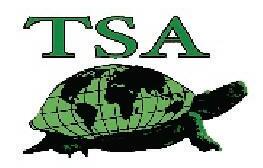
The TSA has grown both in complexity and in our financial obligations to support turtle conservation. And, we will continue to grow. With that growth have come increased expectations and commitments that we must meet – as well as increased operating expenses. The only conservation organization dedicated solely to preventing turtle extinctions, the TSA has grown internationally and expanded our global network. What is amazing is that the TSA has been able to accomplish this growth while relying on a network of dedicated volunteers. But we cannot maintain this growth without a steady and reliable source of revenue. For these reasons, the TSA implemented a dues structure in 2004.
Individual member - $50 annually
Anyone who wants to help turtles is encouraged to become a member at this level. By joining, you will be supporting the TSA’s mission and will be kept up-to-date on the latest news in turtle conservation.
Individual partner - $50 annually
Supporters who join at the partner level are eligible to receive turtles through the TSA network and can apply for TSA grants. Partner applications must be approved by the TSA Steering Committee.
Institutional member - $150 annually
Organizations including zoos, aquariums, universities, museums, botanic gardens and non-governmental organizations are also encouraged to join the TSA and support turtle conservation around the world.


